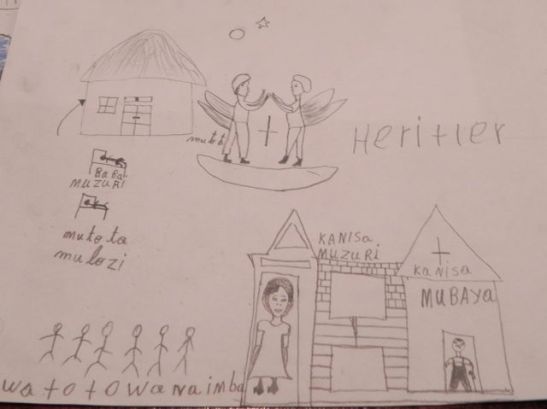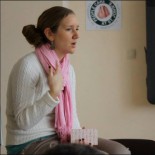Sourcerers, Drunkards and Corpses, Oh My.
I’ve always enjoyed a good skit.
I’ve taught high school, middle school and elementary school and the skits are great at every level. I’d much rather get a sense of what the kids know and understand via skit as opposed to a written Q&A session. When I taught seniors at Charlottesville High School, a pair of girls performed a ridiculous skit with the narrator rapping about the electoral college. My middle schoolers in Kinshasa acted out all sorts of stories from Ancient Greece or the Mongol Empire. But with the mixed age primary class I work with here at the hospital in Goma… well… it’s been a wild ride to say the least.
You might recall the Peace Day skit from back in the Fall… where the initial theme was “If you want peace, prepare for war,” and the skit involved the students using their crutches to pretend-shoot each other… as they fight for peace. Well, that’s nothing compared to the last three skits.
Like in every school around the world, the kids begin to get incredibly antsy for the last thirty minutes of the day. (Teachers do too, we just hide it better.) At our school here we usually save this time for singing, dancing, or storytelling- but sometimes instead we have the kids create and act out a skit. Here is a summary of the last three skits the kids came up with and performed. Keep in mind most of them are between 4 and 10 years old.
Skit #1: Mulozi (The Sourcerer)
There once was a boy with a very good father. One day, the boy went to church by himself, and the very terrible pastor turned him into a sourcerer. After a few nights of waking up in the night screaming, the sourcerer boy killed his father. Then the evil pastor went with the sourcerer and killed everyone in the village, but one of the villagers happened to be traveling so when he came back he found everyone dead… except the bad pastor and the sourcerer. Since the sourcerer was still just a young boy, the villager took him to the next town over where they had a good church with a good pastor. The pastor put his hand on the forehead of the sourcerer and sucked out all the evil spirits and got the young boy to confess that Jesus Christ is the son of God. After that, the boy told the good pastor everything that happened- about how the evil pastor had turned him into a sourcerer and made him kill all those people. So the villager, boy, and good pastor went together to save the evil pastor. The good pastor did the same thing- he put his hand on the evil pastor’s forehead, and sucked all the evil out of him. Then they all lived happily ever after. The end.
After this performance Beatrice reminded the children that they are all good children, and in order to avoid becoming a sourcerer they just need to stick with Jesus.
 Skit #2: Pombe ni Mubaya (Alcohol is bad)
Skit #2: Pombe ni Mubaya (Alcohol is bad)
There once was a family- dad, mom, and two children. The mom was always drunk and hanging around the nganda (bar). One day after school the two children stopped in the bar on the way home. The older brother didn’t like it and wanted to go home, but the younger sister wanted to stay with her mom. So the brother went home and the sister stayed. Then the mom got really drunk and became angry with her daughter so she beat her to death and left her in the bar. When she got home she lied to her husband and said she didn’t know where their daughter was. The son called his mom a liar and told his dad to go check the bar. After the dad found his daughter dead in the bar, he came home and together with his son beat the mom to death. Justice served. The end.
After this performance the kids compared the behavior of drunk people in their home towns. Some imitated a drunken stupor, some explained that drunk people do the weirdest thing- they start to take each other’s clothes off. Beatrice reminded them that drinking too much alcohol is bad.
Skit #3: Ndege, Kidudu na Jamaa Moja (Bird, Insect and a Family)
Students were divided into two groups, and instructed to create a skit with these characters- a bird, insect and a family.
Group 1: The bird feels hungry. The insect crawls up a tree and the bird chases the insect until he finally catches it and eats it. Then the family comes and they feel hungry. They see the bird and chase it until they finally catch it and eat it. The end.
Group 2: Everyone in the family is dead. The insect crawls all over the corpses on the ground. Then the insect gets full so it goes away. Then the bird comes and eats the eyeballs of the dead people. The end.
After group 2’s performance there was an intense class discussion about which animals eat dead people. Half the class said dogs, definitely dogs. They’ve seen it. The other half said snakes, definitely snakes. They’ve seen it. Beatrice confirmed that there are many animals that eat dead people, so that is why we bury them- to protect and respect their bodies.
…
So, I’m around these kids everyday- I know them well. We’re used to each other, comfortable. So our time together always feels normal. And to be perfectly honest, at first I didn’t even think twice about these skits. It wasn’t until I started sharing them with other people, and hearing their reactions, that it began to sink in just how traumatized many of my students are.
I don’t really like to dwell on it too much, mostly because I like to think of and treat them simply as students and as children, rather than as victims. Also, I have made a conscious effort not to share all of their life woes on this blog- not only because I think they are personal woes and deserve to stay private, but also because the world doesn’t need another story about the VICTIMS in Eastern Congo. But I wanted to share these skits as a reminder that-
Yes, people here have seen and experienced incredibly horrific things, and it’s definitely important to know and acknowledge that. But for the most part, our daily lives are not a reflection of those evils. And I wish more people around the world could see that in Congo. So hopefully a majority of this blog has captured the fact that life carries on.
Most of my time in school with the kids is NOT sourcerers, drunkards, and corpses… but rather simply A-E-I-O-U.
My chats with people around town are about family, work, and what’s for dinner.
People go to church for Easter.
To the market on Tuesdays.
To the gas station.
To school.
Even with trauma,
or rather,
in opposition to it?
Life carries on.

Sara, as I read I was thinking what terrible topics the children chose for their skits, but considering what many of them have lived through, I would say the skits were important because they gave the children opportunity to raise and share these stories (maybe some of them had never shared their story before) and at the same time they benefited from Beatrice’s healing wisdom and support. It is totally believable that they don’t live these stories on a day-to-day basis, but I think it does show that the scars are there, and that teachers provide an important avenue for the students to vent and receive advice and words of hope.
Mom
I agree with Sally. Being able to talk about any trauma they have experienced (even through the medium of a skit) is therapeutic. They must feel very safe in your and Beatrice’s class to be able to share these stories. Also, I can see why you don’t want to talk about your students as victims, but maybe you can talk about them as survivors. I find that when a survivor discloses a trauma they have experienced, it sometimes helps to validate how strong and resilient they are for surviving through it.